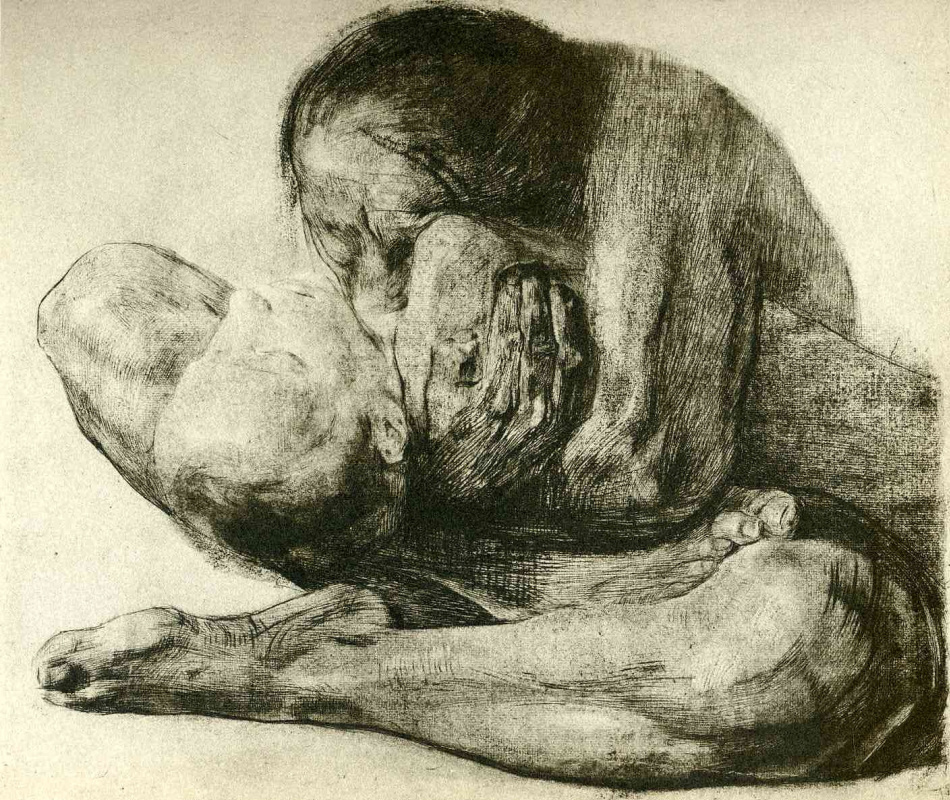log in
Enter site
Login to use Arthive functionality to the maximum
Etching
711 artworks, 63 artists
Etching, or eau forte (fr. eau forte — nitric acid, literally, “strong water”) is a technique of printed graphics, in which artists use a chemical reaction of a metal with an acid. The artist polishes a zinc, iron or copper plate and paints it with an acid-resistant varnish made of a mixture of wax and resin. Then the engraver scratches the lines of the future design with an etching needle and immerses the plate in a bath of acid. Etching time determines the stroke depth and colour saturation. At the end of the process, the artist rinses off the protective coating with turpentine, rubs the black paint into the recesses on the metal and, using a printing press, transfers the image to wet paper.
German master Daniel Hopfer invented the etched stroke technique at the beginning of the 16th century. The innovation delighted the artists-engravers: the speed of the plate processing, accurate reproduction of hand movements, clarity and subtlety of the stroke, the 500 sheets print run without loss of image quality made the etching graphics popular for five centuries.
The talented and persistent self-taught engraver Rembrandt van Rijn became the greatest master of etching. The Dutchman created exquisite and expressive images that serve as a model for printed graphics even in the 21st century. His Diana Bathing 1631, Adam and Eve 1638, Christ Presented to the People 1655 engravings remind painting with their shade richness and detail, perspective depth, play of light and shadow. On the contrary, Self-Portrait with Beret and Turned-Up Collar 1630, A Turkish Slave, The Blind Fiddler 1631, The Little Jewish Bride 1638 are surprisingly intimate and laconic: rare and blurred strokes slightly appear on paper, but convey the depth of the character’s emotions. The etchings by Francisco Goya from the Caprichos series are filled with Spanish temperament: the images are contrasting, the subjects are dramatic, and the figures are grotesque. American James Whistler preferred a “subtle and delicate” etching style. The Nocturne 1880, Thames 1896 landscapes resemble soft chalk drawings, in which the city spiers and ship masts appear through a veil of fog. The name of the engraver-illustrator William Blake stands apart in the list of artists. The poet draftsman developed his own etching method and printed exquisite illustrations (Compassion 1795, Horse 1805) and text on one sheet (Frontispiece of William Haley’s Ballad Collection 1802).
Famous etching pictures: Peasant Family 1647 by Adriaen Jansz. van Ostade; Caprichos series 1799, The Colossus 1818 by Francisco Goya; Net of Religion 1794, Illustrations to the Ballads of William Haley 1805 by William Blake; Virgin in the Tree, Two Men Meet, Each Believing the Other to Be of Higher Rank 1903 by Paul Klee; Labyrinth of the World and Paradise of the Heart series 1989 Albín Brunovský.
Famous artists who practiced the art of etching:
Jan Lievens, Adriaen Jansz. van Ostade, Rembrandt van Rijn, Francisco Goya, William Blake, Paul Klee, Albín Brunovský.
German master Daniel Hopfer invented the etched stroke technique at the beginning of the 16th century. The innovation delighted the artists-engravers: the speed of the plate processing, accurate reproduction of hand movements, clarity and subtlety of the stroke, the 500 sheets print run without loss of image quality made the etching graphics popular for five centuries.
The talented and persistent self-taught engraver Rembrandt van Rijn became the greatest master of etching. The Dutchman created exquisite and expressive images that serve as a model for printed graphics even in the 21st century. His Diana Bathing 1631, Adam and Eve 1638, Christ Presented to the People 1655 engravings remind painting with their shade richness and detail, perspective depth, play of light and shadow. On the contrary, Self-Portrait with Beret and Turned-Up Collar 1630, A Turkish Slave, The Blind Fiddler 1631, The Little Jewish Bride 1638 are surprisingly intimate and laconic: rare and blurred strokes slightly appear on paper, but convey the depth of the character’s emotions. The etchings by Francisco Goya from the Caprichos series are filled with Spanish temperament: the images are contrasting, the subjects are dramatic, and the figures are grotesque. American James Whistler preferred a “subtle and delicate” etching style. The Nocturne 1880, Thames 1896 landscapes resemble soft chalk drawings, in which the city spiers and ship masts appear through a veil of fog. The name of the engraver-illustrator William Blake stands apart in the list of artists. The poet draftsman developed his own etching method and printed exquisite illustrations (Compassion 1795, Horse 1805) and text on one sheet (Frontispiece of William Haley’s Ballad Collection 1802).
Famous etching pictures: Peasant Family 1647 by Adriaen Jansz. van Ostade; Caprichos series 1799, The Colossus 1818 by Francisco Goya; Net of Religion 1794, Illustrations to the Ballads of William Haley 1805 by William Blake; Virgin in the Tree, Two Men Meet, Each Believing the Other to Be of Higher Rank 1903 by Paul Klee; Labyrinth of the World and Paradise of the Heart series 1989 Albín Brunovský.
Famous artists who practiced the art of etching:
Jan Lievens, Adriaen Jansz. van Ostade, Rembrandt van Rijn, Francisco Goya, William Blake, Paul Klee, Albín Brunovský.
Feed

